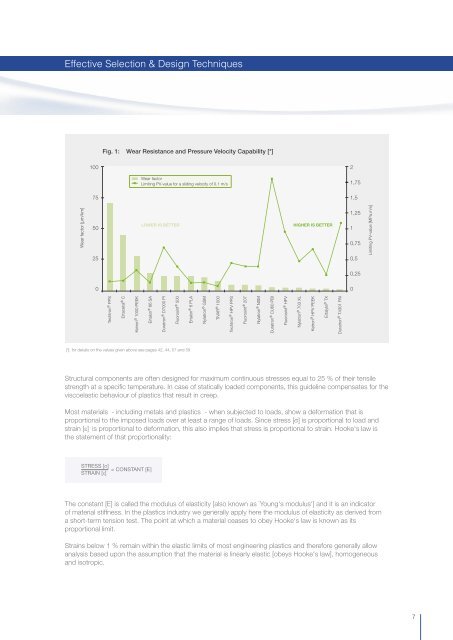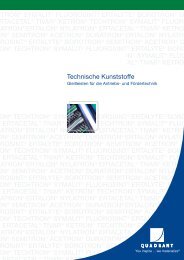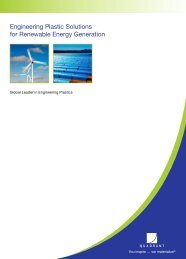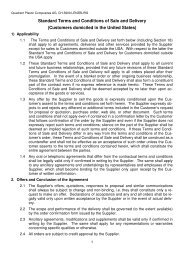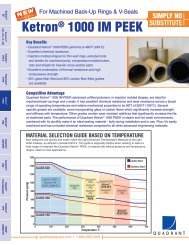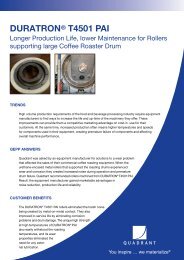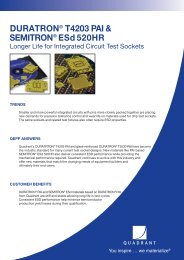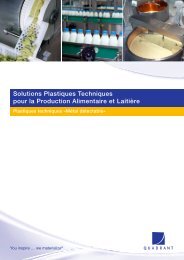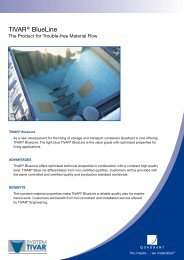Product Guide for Design Engineers - Quadrant
Product Guide for Design Engineers - Quadrant
Product Guide for Design Engineers - Quadrant
You also want an ePaper? Increase the reach of your titles
YUMPU automatically turns print PDFs into web optimized ePapers that Google loves.
Effective Selection & <strong>Design</strong> Techniques<br />
Fig. 1: Wear Resistance and Pressure Velocity Capability [*]<br />
100<br />
2<br />
Wear factor<br />
Limiting PV-value <strong>for</strong> a sliding velocity of 0.1 m/s<br />
1,75<br />
75<br />
1,5<br />
Wear factor [µm/km]<br />
50<br />
25<br />
LOWER IS BETTER<br />
HIGHER IS BETTER<br />
1,25<br />
1<br />
0,75<br />
0,5<br />
Limiting PV-value [MPa.m/s]<br />
0,25<br />
0<br />
0<br />
Techtron ® PPS<br />
Ertacetal ® C<br />
Ketron ® 1000 PEEK<br />
Ertalon ® 66 SA<br />
Duratron ® D7000 PI<br />
Fluorosint ® 500<br />
Ertalon ® 6 PLA<br />
Nylatron ® GSM<br />
TIVAR ® 1000<br />
Techtron ® HPV PPS<br />
Fluorosint ® 207<br />
Nylatron ® NSM<br />
Duratron ® CU60 PBI<br />
Fluorosint ® HPV<br />
Nylatron ® 703 XL<br />
Ketron ® HPV PEEK<br />
Ertalyte ® TX<br />
Duratron ® T4301 PAI<br />
[*]: <strong>for</strong> details on the values given above see pages 42, 44, 57 and 59<br />
Structural components are often designed <strong>for</strong> maximum continuous stresses equal to 25 % of their tensile<br />
strength at a specifi c temperature. In case of statically loaded components, this guideline compensates <strong>for</strong> the<br />
viscoelastic behaviour of plastics that result in creep.<br />
Most materials - including metals and plastics - when subjected to loads, show a de<strong>for</strong>mation that is<br />
proportional to the imposed loads over at least a range of loads. Since stress [] is proportional to load and<br />
strain [] is proportional to de<strong>for</strong>mation, this also implies that stress is proportional to strain. Hooke‘s law is<br />
the statement of that proportionality:<br />
STRESS []<br />
STRAIN []<br />
= CONSTANT [E]<br />
The constant [E] is called the modulus of elasticity [also known as `Young‘s modulus‘] and it is an indicator<br />
of material stiffness. In the plastics industry we generally apply here the modulus of elasticity as derived from<br />
a short-term tension test. The point at which a material ceases to obey Hooke‘s law is known as its<br />
proportional limit.<br />
Strains below 1 % remain within the elastic limits of most engineering plastics and there<strong>for</strong>e generally allow<br />
analysis based upon the assumption that the material is linearly elastic [obeys Hooke‘s law], homogeneous<br />
and isotropic.<br />
7


